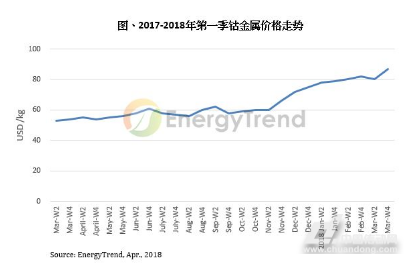According to the latest observation by the Energy Trend Institute, cobalt-metal prices continued to rise in 2018 and rose by more than 20% in the first quarter, indicating that raw material prices were affected by short-term capital speculation and the overall industry supply distribution was too concentrated. Push up prices continued to rise in the medium to long term. For the lithium battery and new energy automotive industry, it is necessary to begin to reflect the cost of materials quarter by quarter, but also test the battery industry as soon as possible to adjust to reduce the dependence on cobalt metal.
Lv Lie, senior research manager of EnergyTrend, pointed out that the price trend of lithium batteries has always been concerned by the market. Before the new generation of materials matures, the use of cobalt metal is the easiest way to increase energy density. However, as the price of cobalt metal hit new highs, it rose from US$32/kg in 2017 to US$75/kg (+114% annually), while the price in the first quarter of 2018 increased to as high as US$95/kg. (26% increase in the quarter), adding new variables to the outlook for the development of the new energy vehicle industry.

However, the change in cobalt metal prices is mainly influenced by speculative speculation in the market. The price trend is not determined by supply and demand, but depends unilaterally on the supply side. In addition, many second-tier battery cells and battery cathode material plants have been greatly affected in this wave of raw material price fluctuations. Not only the procurement costs are higher than that of large plants, but system manufacturers and brand manufacturers also rely on manufacturers for cost considerations. Loss of the market's diversified supply and healthy competition.
However, although cobalt metal is still in the seller's market, the proportion of cobalt metal in the cell core of IT products is less than 5%, so the terminal sales price of consumer products has a limited impact.
Reduce cost pressure, NMC formula mixed into one of the main direction of development of battery factory
Lü Li said that it is imperative for system manufacturers and brand manufacturers to accelerate the development of more advanced material alternatives to get rid of the constraints of raw materials. In addition to the high nickel products often used in the past, lithium-ion batteries with silicon oxide as the negative electrode material have been produced in large quantities. It is even more urgent.
Unlike the above two schemes for increasing energy density, the practice of using NMC formula BlendedPolymer lithium cobalt cathode material (LCO) is nearly 20% lower than LCO, but it can effectively reduce costs, and is expected to become a manufacturer's commitment to development. The direction, including Samsung SDI, LK Chemical, Lishen, and other major cell suppliers, have all proposed hybrid solutions (>20% NMC). However, due to the application of NMC materials in polymer batteries, it is still necessary to improve the expansion rate. Therefore, the industry has not yet accumulated complete R&D experience. It is expected that in the second half of 2018, there will be a chance to see a small amount of blended mixed-mode batteries entering the market. However, if the cobalt price declines rapidly in the future and there is still a market value for the blended blend, further observations are still needed.
Industrial and Medical Display
There are many kinds of LCD classification standards, which can be divided into passive matrix and active matrix according to the driving mode
Passive matrix: Passive matrix LCD can be divided into TN-LCD(TwistedNematic LCD), STN-LCD(SuperTN-LCD) and DSTN-LCD(Doublelayer STN-LCD).
Active matrix: Active matrix LCD, also known as TFT-LCD, is widely used at present. Tft-lcd is short for thin-filmliquid-Crystal Display
The TFT-thin Film Transistor
Liquid Crystal Display
Short for TFT-LCD Liquid-CrystalDisplay
Tft-lcd has been widely used in various display equipment due to its advantages of small size, light weight, low radiation, low power consumption and full color.
Functions of TFT-LCD structure
(1) Backlight plate module: provide the source of light;
(2) Upper and lower polarizing plates, TFT Glass Substrate, liquid crystal: forming polarized light, controlling the passage of light;
(3) Color filters: Provide TFT LCD red, green and blue (three primary colors of light) sources;
(4) ITO transparent conductive layer: provide transparent conductive path;
(5) Photo Spacer: Provide a fixed height for color filters and TFT Glass Substrate. As a space for liquid crystal infusion, and as a support for the upper and lower Glass layers.
Medical Display,Medical Lcd Monitor,Medical Monitor,Medical Grade Monito
TONYA DISPLAY LIMITED , https://www.tydisplay.com